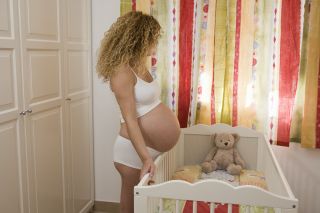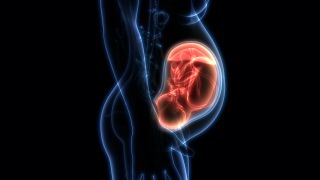Signs of labor: 6 clues baby is on the way
Find out how to spot the common signs of labor and discover some things you can do to promote labor.

The signs of labor can differ from one woman to another, and even for the same woman they may change from one pregnancy to the next. Although there's no way to predict how a woman's labor will progress or how long it will last, there are a few common signs of labor. What initiates labor, however, is less clear.
"We don't really know what mechanisms bring on labor," said Leslie Ludka, a certified nurse midwife and the director of midwifery at Cambridge Health Alliance in Cambridge, Mass. "Science hasn't figured this out yet."
Labor is likely initiated when certain hormones are produced by the fetus, according to the journal Molecular Endocrinology. Below is more information on the physical signs of labor.

Yasmine S. Ali, MD, MSCI, FACC, FACP, is an award-winning physician writer who has published across multiple genres and media. She is President of LastSky Writing, LLC, and has 25 years of experience in medical writing, editing, and reviewing, across a broad range of health topics and medical conditions.
Signs of labor
One sign that labor may be approaching in a matter of days is when some women experience a "nesting" instinct, according to the International Journal of Childbirth Education. Although tired at this late stage of pregnancy, some women may feel a sudden burst of energy, and the desire to cook, clean and get the house organized before the baby arrives.
A 2013 study by Canadian researchers in the journal Evolution and Human Behavior found that nesting behaviors peak during a woman's third trimester of pregnancy. Similar to its role in the animal kingdom of preparing a safe environment for the new arrival, nesting in women may also serve a protective function, the authors wrote.
The body can give off other clues that a woman might be going into labor. Below are six common signs of labor.

1. The baby drops
Another sign of labor is known as "lightening." According to the Cleveland Clinic, this occurs anywhere from a few hours to a few weeks before labor begins in first-time pregnancies, and a woman may look and feel as though the baby has dropped into a lower position in her pelvis. This means the baby is getting into a head-down position in preparation for birth. In women who have previously given birth, lightening may not occur until right before labor begins.
When the baby settles into a lower position, this eases pressure on a woman's diaphragm, making it easier for her to breathe, according to The American College of Obstetricians and Gynecologists. But it also puts more pressure on her pelvis and bladder, resulting in frequent bathroom visits. In addition, a woman's belly may appear lower and more protruding, and she may walk with a waddle.
2. Regular contractions
Contractions may also be a sign of labor. A woman's uterus contracts during her entire pregnancy, Ludka said. "It's a muscle, and it has to practice for this Olympic event that is going to happen," she explained.
Near the end of pregnancy, uterine contractions start to move the baby down into a lower position in the birth canal, and ultimately having contractions will help to push the baby out into the world.
True labor involves regular, rhythmic, intense contractions that become closer than five minutes apart for more than an hour or two, Ludka said. The contractions usually start in a woman's back and then come around to the front, she said.
"The abdomen gets hard, hard, hard like a basketball and then it relaxes," Ludka explained. "Real contractions feel like that."

False labor contractions vs. real labor contractions
Distinguishing between false contractions and real ones can be tricky, according to the journal Social Science and Medicine. If a pregnant woman is having more than six contractions every hour, and they become stronger and rhythmic (meaning they occur at regular intervals), then pay attention, because the baby is on its way, Ludka said. True labor contractions don't go away even if a woman changes position, such as moving around or laying down.
Ludka said that people don't often know how to time contractions correctly. It's done by timing from the beginning of one contraction to the start of the next one, including the rest time in between them.
False labor contractions, called Braxton Hicks contractions, often occur at irregular time intervals, they do not get closer together over time, and they'll eventually subside, according to the American College of Obstetricians and Gynecologists.
Unlike true labor, false contractions are usually felt in the front of the body in the lower abdomen, are typically weak, and may stop when a woman walks, rests or otherwise changes her position.
3. Water breaks

The fetus has been growing and developing in a woman's uterus surrounded by amniotic fluid. When this protective sac of fluid ruptures (a process also called "rupture of membranes"), some women experience a gush of liquid, while for others it's a slow trickle, according to the Journal of Advanced Medical and Dental Sciences Research.
A pregnant woman's water can break days before labor starts, during labor or not at all (in which case an obstetrician or midwife will break it during the delivery), Ludka said. She advised mothers-to-be to call their obstetrician or midwife when their water breaks and describe the fluid's color and odor. This can help a health professional determine whether an expectant woman is leaking urine, which is a common symptom during pregnancy, or amniotic fluid.
Once a woman's water breaks, the baby is no longer surrounded by the protective sac and could be at risk of developing an infection, according to the U.K.’s National Health Service (NHS). This is why doctors and midwives will want to deliver the baby within a day or two of the water breaking.
4. Lower back pain & cramping
During labor, a woman might feel increasing pressure or cramping in her pelvic and rectal areas. She may also feel a dull ache in her lower back.
According to a study published in the American Journal of Obstetrics and Gynecology, most people feel pain in the abdominal area. For some, back pain can be felt during contractions, while for others there is continuous low-back pain.
The study found that about 33% of women experience continuous lower back pain during labor.

5. Bloody show
As labor begins, or several days before it does, a woman may notice an increase in vaginal discharge that's pink, brown or slightly bloody. Called a "bloody show," this discharge is caused by the release of a mucus plug that blocks the cervix (the opening to the uterus) during pregnancy, according to the Cleveland Clinic. The mucus plug loosens up as the cervix begins to dilate, or open up, during the first stage of labor.
6. Diarrhea or nausea
Some women have frequent loose stools at the beginning of labor, or they may start vomiting for reasons that aren't clear, Ludka said. It's also often unknown which started first; for example, whether the diarrhea occurred and then labor began, or if labor started and this caused diarrhea, she explained.
Ways to promote labor
There are several old wives' tales and cultural beliefs about what might get labor started. Some of these labor-induction methods may actually work, while others are ineffective.
In one study of 200 women who had just given birth, more than half of the women surveyed said they had tried at least one method to bring on labor during their final weeks of pregnancy, Live Science previously reported. Of those women, 85% reported that they had tried walking, 45% tried having sex, 22% ate spicy food and 15% tried stimulating their nipples.

According to Ludka, a woman won't bring on labor by eating spicy foods, driving down a bumpy road, or taking long walks — three popular old wives' tales. However, two techniques that may get the process started are having sex and stimulating the nipples, Ludka told Live Science.
Having sex might not be comfortable at this point in pregnancy, but sperm contain prostaglandins, a hormone-like compound that can soften up the cervix and help get labor underway, Ludka explained.
She also said that stimulating the nipple by hand can help bring on labor for a woman who is at her due date and is having a normal, healthy pregnancy. This method may help release oxytocin, a hormone that can cause uterine contractions.
A woman can try nipple stimulation by rolling one nipple between her fingers until a contraction occurs, Ludka advised. Once the contraction takes place, she should stop rolling and wait a full 5 minutes before doing it again. This method can be done for an hour or two. Ludka recommended that women never roll both nipples at the same time because this can create too many uterine contractions, or ones that are too strong.
Additional resources
Learn what happens during each stage of labor and birth in this article by NHS U.K. To know more about the position of a baby during labor, read the Cleveland Clinic’s page: Fetal Positions for Birth.
Editor's Note: If you'd like more information on this topic, we recommend the following book:
Bibliography
"Evidence of a nesting psychology during human pregnancy". Evolution and Human Behavior (2013). https://www.sciencedirect.com/science/article/abs/pii/S1090513813000706
"How to Tell When Labor Begins". The American College of Obstetricians and Gynecologists. https://www.acog.org/womens-health/faqs/how-to-tell-when-labor-begins
"Minireview: Fetal-Maternal Hormonal Signaling in Pregnancy and Labor". Molecular Endocrinology (2009). https://academic.oup.com/mend/article/23/7/947/2683942?login=true
"A Basic Revisited: Teaching About the Onset of Labor". International Journal of Childbirth Education (1993). https://www.proquest.com/openview/12a70e647c3295b5e932ef4668ee6af1/1?pq-origsite=gscholar&cbl=32235
"Recognizing active labor: A test of a decision-making guide for pregnant women". Social Science and Medicine (1982). https://www.sciencedirect.com/science/article/abs/pii/0277953682900624
"A comparative study of different concentrations of Hyoscine Butyl bromide in labor ". Journal of Advanced Medical and Dental Sciences Research (2019). http://jamdsr.com/uploadfiles/31HyoscineButylbromideinLaborvol7issue6p117-120.20190713051708.pdf
"Low-back pain during labor". American Journal of Obstetrics and Gynecology (1987). https://www.sciencedirect.com/science/article/abs/pii/0002937887903498
Sign up for the Live Science daily newsletter now
Get the world’s most fascinating discoveries delivered straight to your inbox.
Cari Nierenberg has been writing about health and wellness topics for online news outlets and print publications for more than two decades. Her work has been published by Live Science, The Washington Post, WebMD, Scientific American, among others. She has a Bachelor of Science degree in nutrition from Cornell University and a Master of Science degree in Nutrition and Communication from Boston University.